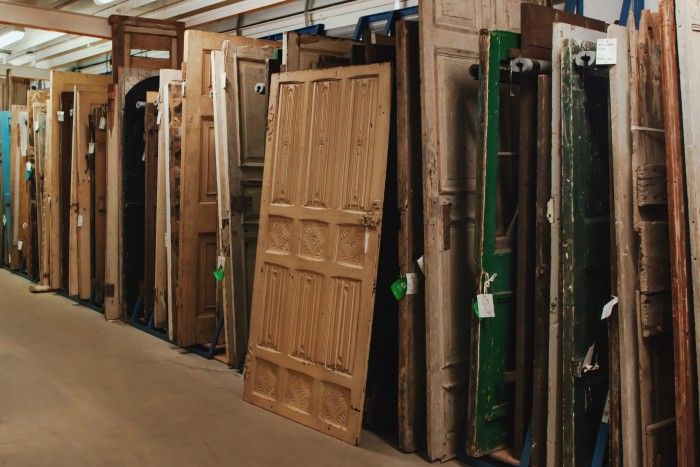Sally Johnson pulls back the cover of an archival folder to reveal a piece of wallpaper that is torn at the edges but mounted on card like an artwork. Dating from c1690-1700, its repeated pattern of pagoda-like structures and Turkish-inspired figures was block-printed by hand in black on to a background that the collections conservator says was probably lighter before it absorbed years of “grime.”
The design might not be factually accurate, says Dickon Whitewood, curator of collections and interiors for the east region at English Heritage. However he says the wallpaper, salvaged from a late 17th-century terrace house in south London in the 1960s, is a “small window” into the growing global cultural exchange at the time. “It is interesting that people even in the 1600s are showing an increased awareness of other parts of the world, they are trying to advertise to anybody that’s coming to their house that they are knowledgeable,” he says.
The fragment is the earliest piece of wallpaper in English Heritage’s Architectural Study Collection (ASC), a curious mix of more than 7,000 items gathered from buildings in London, from door knockers to dice rails, fire surrounds to balustrades. It’s all kept in the Archaeological Collections Store at Wrest Park, Bedfordshire, which also houses artefacts from the charity’s historic sites in the east of England and the Midlands, and is open for public tours on selected dates until October.
The ASC has its origins in the early 20th century when architects and surveyors working for the then London County Council grew concerned about “a loss of history, architectural detail [and] social history,” says Whitewood. “So people started, when buildings were knocked down [or refurbished]to collect an assortment of the features that were being lost.”
The first objects salvaged were pieces of woodwork from 17th and 18th-century buildings in Aldwych in 1902, he says. From there, the assortment grew to encompass items from humble homes to royal residences, as well as non-domestic buildings, with active collecting continuing into the 1990s.
Today the ASC spans Roman sculpture to 1980s tools, but is particularly strong for 18th and 19th century interiors. There are more than 1,200 records for wallpaper alone, in addition to nearly 6,000 other items, including a playful late 19th-century Noah’s Ark design taken from what was probably a child’s room. A piece of red floral flock wallpaper, created by sprinkling fibers over adhesive to give a textile effect, was collected from the front room of a Grade II*-listed townhouse on Soho Square that was being refurbished in 1985. Research found cabinetmaker Thomas Chippendale supplied the paper in 1760.
The second world war Blitz and the clearance that followed led to significant additions to the ASC. Brooke House in Hackney, east London, once owned by King Henry VIII, was demolished in the 1950s due to bomb damage, with a fragment of the Tudor ceiling in the long gallery among items saved.

German incendiary bombs largely destroyed the 17th-century Holland House in Kensington, the remains of which are Grade I-listed, in 1940. 19th-century terracotta bricks from a garden wall, salvaged from the Jacobean mansion in 1955, feature decorative detail including a Cherub riding a mythical sea beast. A more peculiar piece believed to have been saved from the ruins is an undated tin, heart-shaped air freshener, which Johnson, collections conservator for the East of England at English Heritage, says would have housed dried rose petals and hung on a wall.
The piece demonstrates the “fun nature” of the ASC, adds Whitewood. “It is a collection of objects that people found interesting and wanted to save. “People didn’t go out of their way to collect a set type of object or from a set period of history.” The ASC only got its first curator, Treve Rosoman, in the 1980s.
Whitewood says exploring the collection, largely stored floor-to-ceiling on pallets, can be a “slightly strange sensation.” It is certainly distracting: my eye is drawn high and low, from one seemingly random object to the next. While looking at given rails I spot three interior columns from Hampton Court Palace, from around the late 17th century, propped up against the wall. In another aisle a balustrade, with part of the stairs still attached, lies on its side as if that is where it was felled.
Particularly eye-catching are six almost 8ft-high bell jacks that once stood atop the former covered Columbia Market in east London. These 19th-century wooden figures are a regular feature on paid public tours of the Archaeological Collections Store, which also include wallpaper this year.
Responsibility for caring for the ASC falls to Johnson. “There’s not one particular type of object that’s specifically problematic, it’s the fact that we’ve got such a mix of objects in one space,” she says.
Green asbestos warning tags hanging from some of the doors slotted in a rack along one wall indicate one of the hazards for which Johnson and her colleagues have to check. “Anthrax is another one, which surprised me,” says Whitewood. “I thought anthrax was a weaponized thing but it’s natural and lives in horsehair” — an ingredient in some plasterwork. Johnson wears gloves to handle the wallpaper: arsenic was used to increase the brightness and durability of green in the 19th century.


On the way out of the store, we pass a lead faun that Johnson says has “melted into himself” — it may have been damaged by a knock or because its internal armature was removed or failed. The piece, “Dancing Faun” (after the antique) by 18th-century English sculptor John Cheere, once stood in the grounds of Mount Clare, a Grade I-listed house in Roehampton, south-west London.
“I forget he’s there because he used to be in a different aisle,” says Johnson. “I’ll come around the corner and it makes me jump every time I see it.” When and why this sculpture made it into the collection is unclear.
Only the “bare bones” are currently known about the people who collected objects for the ASC and why, says Whitewood, although this is something that could be explored in the future. For now, the focus is digitizing the ASC’s paper records in the hope of discovering more about the items. Whitewood says there is a “longer-term aspiration” for the collection to be put online.
But what does the ASC tell us about decor in the UK capital over centuries? “So many of the objects show a real skill on behalf of the craftsmen that you don’t see anymore. . . No matter who you were there was a real appreciation of decoration on buildings, which probably we are losing, certainly in London,” he says. The collection is “a real testament to that lost London”.
For information on occasional guided tours for the public and viewings by appointment, see english-heritage.org.uk
Find out about our latest stories first — follow @FTProperty on X or @ft_houseandhome on Instagram










